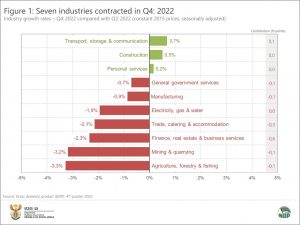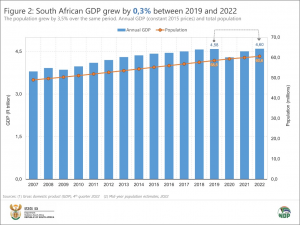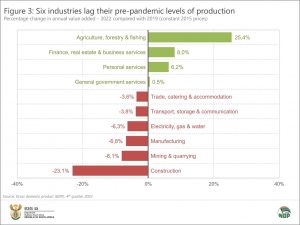PHUTI MOSOMANE
After rallying in the third quarter of 2022, South African gross domestic product (GDP) declined by 1,3% in the fourth quarter (October‒December), Stats SA announced on Tuesday.
Growth was dragged lower mainly by finance, trade, mining, agriculture, manufacturing and general government services.
Finance and trade the biggest drags on growth
Seven of the ten industries contracted in the fourth quarter. The finance, real estate and business services industry shrank by 2,3%. This was on the back of lower economic activity in financial intermediation, insurance and pension funding and auxiliary activities. As the finance, real estate and business services industry is the largest in the South African economy, the 2,3% decrease was the biggest factor behind the decline in GDP, subtracting 0,6 of a percentage point from GDP growth (Figure 1).

The trade, catering and accommodation industry was the second largest negative contributor to growth, recording a contraction of 2,1%. This was mainly due to a decline in wholesale trade.
Mining output was dragged lower by a decline in the production of diamonds, iron ore and platinum group metals (PGMs).
Economic activity in the electricity, gas and water supply industry was hampered by lower levels of production and consumption of electricity (mainly due to load shedding) and water.
Agriculture recorded the largest contraction in the quarter (-3,3%), pulled lower mainly by weaker production figures for field crops and horticulture products.
On the positive side, transport, storage and communication, construction and personal services were the bright spots in the fourth quarter. Transport, storage and communication made the largest positive impact, rising by 0,7% and contributing 0,1 of a percentage point to growth. This was mainly due to increased economic activity in passenger land transport, air transport and communication services.
Economic growth flat since 2019
The fourth quarter data concludes the results for the calendar year, providing an opportunity to revisit the annual GDP series. The South African economy grew for a second consecutive year, expanding by 2,0% between 2021 and 2022, from R4,50 trillion to R4,60 trillion.
Although GDP reached an all-time high in 2022, the economy has only grown by 0,3% from the 2019 pre-pandemic reading of R4,58 trillion. This lags behind the 3,5% rise in the country’s population over the same period (Figure 2).

Exploring the economy in more detail, six industries have yet to recover to their pre-pandemic levels of production (Figure 3). Construction is the worst in shape, remaining 23,1% smaller than what it was before the pandemic. In fact, construction’s woes started way before COVID-19. A shadow of its former self, 2022 marked construction’s sixth consecutive year of economic decline.

On the upside, South African agricultural activity was robust in the face of the pandemic. The industry grew strongly in 2020 while many other industries faltered, following up with further gains in 2021 and 2022. The finance, real estate & business services industry also recorded positive growth figures for all three years, although not as strong as agriculture.

